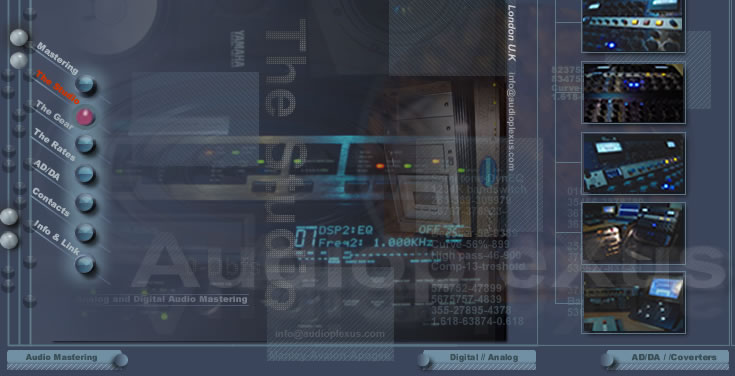
Acoustic by primacoustic and auralex. Designed to give the best possible listening comfort with acoustic neutrality on wide range of frequency and minimal low frequency standing wave.The system is fully balanced and wired with high grade microphone cables.
A 140 point patch bay for easy access to all the gears and monitors. 3 headphone point for flexibility around the room .The Power is conditioned and cleaned by ETA and Monster power Wooden floor with carpeting for minimal reflection The studio is air conditioned for comfort.Internet.Video.
Acoustic sound diffusion keeps sound waves from grouping, so there are no hot spots or nulls in a room. In fact, sound diffusion greatly widens the "sweet spot" and lends a strong, 3D sense of openness to a room, making it easier to hear "into" a mix. Diffusion obliterates standing waves and flutter echoes without simply removing acoustic energy from the space or greatly changing the frequency content of the sound. Some famous recording artists like to perform in strongly diffusive environments because of the openness they hear. Acoustic sound diffusion can make a small space seem large and a large space seem even larger.
Please note that the above are not specific instructions but some processes that may or may not be applied. Audio Mastering needs to examine the adjectives of input media, the expectations of the source producer or recipient, the limitations of the end medium and process the subject accordingly. General rules of thumb can rarely be applied.
Mastering Low frequency sound waves are so long - and thus so strong - they are the toughest to control. This is true no matter whether you're attempting to block their transmission to a neighboring space or trying to absorb them to clean up the low frequency response within a room. Controlling low frequency sound is harder than controlling mid or high frequency sound and generally requires more effort and expense. Luckily, the Auralex line of acoustic bass traps can help.
Process The process of Audio Mastering varies depending on the specific needs of the audio to be processed. Steps of the process typically include:
- Sequence the recorded audio as it will appear on the final product.
- Correct any problems with the audio, such as volume level, tonal balance, or undesireable artifacts.
- Transfer the audio to the final master format.
Examples of possible actions taken during mastering:
- Apply noise reduction to eliminate hum and hiss.
- Normalize the tracks to set the highest peaks in audio volume to a preset level; the overall audio should never exceed 0 dBfs.
- Equalize audio between two tracks to ensure there are no jumps in bass, treble, midrange, volume or pan.
- Apply a compressor (for example, 4:1 starting at -6 dB) to comspres the peaks but to expand the softer parts.
- Apply a dynamics compressor to compress only specific frequencies that generate the audio peaks.
- In the case of mastering for broadcast, the bandwidth of the signal has to be reduced. For example for TV broadcast: apply a high-pass filter at 80 Hz with -18 dB/octave to filter out low frequencies and apply a low-pass filter at 12 kHz with -9 db/octave to filter out high frequencies.
Audio mastering is the process of preparing and transferring recorded audio to a medium for future duplication. The specific medium that receives the mastered audio varies, depending on the intended release format of the final product. This medium is then used as the master copy, from which all further production of the audio material will be based